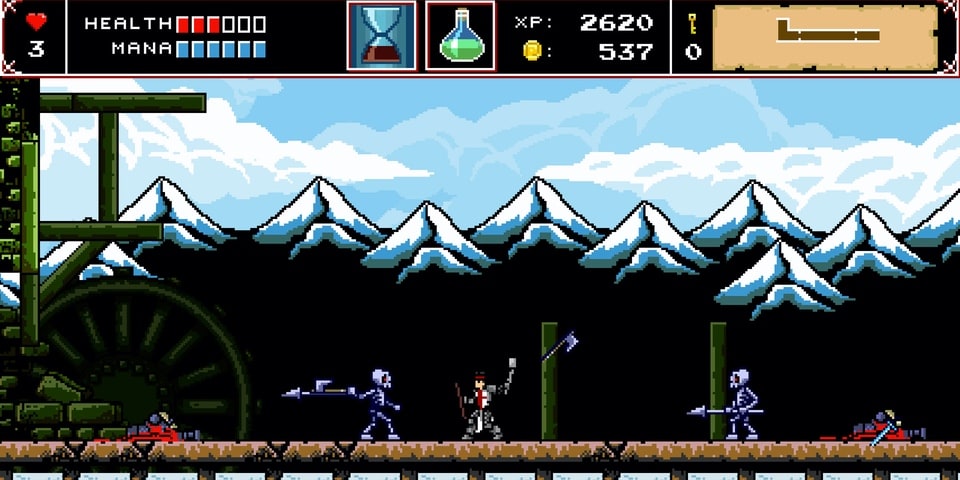Infernax Review

Infernax warns player that the game contains ‘saucy language, acts of violence in the name of justice, copious amounts of gore, and half clothed demon people of varying degrees of attractiveness’. This might lead you to believe this is an edgy try-hard game, but in actual fact Infernax is a love letter to retro platformer titles like Castlevania. That isn’t to say that there isn’t a ridiculous amount of gore to be found here, but there is real heart alongside all that blood.
Infernax is clearly visually inspired by classic NES and 8-bit computer titles but the pixel graphics are actually unusually complex here and the colour scheme has more in common with 16-bit titles. The result is something between, a 12-bit fusion that has a charm and feel all of its own. It may not change the minds of pixel art haters, but it is far more imaginative and skilful than many other titles that employ such an aesthetic. Enemies are nicely designed and have distinctive and challenging movement sets and attacks with a hint of a Souls-like influence.
You play as Lord Alcedor, a knight returning to his home country (apparently from the Crusades given his costume) only to find it beset with demons and monsters. In an unrealistic portrayal of aristocratic benevolence, you must set out to find the cause of this evil and vanquish it. To do so you’ll explore a Metroidvania-inspired world, uncovering new areas with new abilities and using your trusty mace to smash the evil from your land. Castlevania is a clear influence in terms of look and feel, but there is also an uncanny similarity to Dante’s Inferno from 2010, not least through the implementation of a morality mechanic that sees you either saving or slaying various characters throughout the game – the results of which can unlock some radically different paths.

The key aspects of Infernax are the controls and the level design, and fortunately these are both strong points. Alcedor is a solid fighter, but has a jump that has just enough control to get you out of some tough spots, while the skills and magic powers you unlock can be combined to navigate some fiendish areas. There is perhaps an over-reliance on instant death pits, but this is clearly in keeping with the difficulty of the game’s influences.
The world map contains some ingenious shortcuts and it is usually clear when your progress requires a new ability. The one exception to this was a boss level that requires you to take notice of what NPCs say in order to work out what is needed. This kind of puzzle was a nice addition and it’s a shame that there wasn’t more scope for this approach.
Boss battles are the real highlight of the combat here, with some memorably disgusting designs to confront. Each of these bosses explodes in torrents of gore when defeated, and Alcedor continues to wear the bloody mark of his fights until you pray and save at a shrine. XP can be turned into player upgrades here and you will also find gold that can buy spells and upgrades to armour and weapons. These are essential if you want to make progress (in some cases literally, as certain spells are needed to access particular areas) so it is worth grinding once in a while to make sure you can buy everything in each village that you come across.

There are two main difficulty settings available at the start of the game, Classic and Casual. The former works like an old school title, with infrequent checkpoints whilst Casual offers up extra lives to retry areas. Casual is still not a walk in the park, though, and is enough of a challenge to be enjoyable and work as training for trying the harder modes. There are also hidden character types which I have yet to try out, including one that relies on the well known Konami code and completely changes the game.

